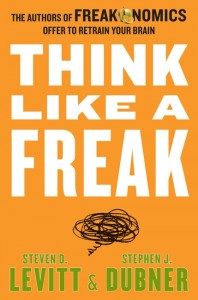
The first two books in the Freakonomics series by Stephen Dubner and Steven Levitt told entertaining stories to illustrate broader economics principles. The third installment ”” Think Like a Freak ”” follows the same tradition, but is bolder. In addition to entertaining you, it wants to teach you how to think… like a freak/economist.
To their credit, these authors have done as much as anyone to popularize economics and the economics approach to problem-solving and life. They remain likeable and humble, despite their huge success. They readily admit that much of their advice is common sense or obvious, at least upon reflection. In fact, to understand the book’s core insights, you don’t necessarily have to ”œthink like a freak”, you just have to think. Period.
They cover lots of terrain in about 200 pages. I’ll try to summarize their main points with the following fortune-cookies written by economists:
On what we know: People rarely say ”œI don’t know” when they truly don’t know because they worry other people will think less of them. Alternatively, many pundits think they know everything, including the future.
On learning: The key to learning is getting good feedback, so experiment often to discover what works and what doesn’t.
On problem-solving: To gain useful insights, it’s crucial to refine and redefine problems. Bring child-like wonder to your problems and set aside your preconceptions (and sometimes your morals). Thinking freely means you’ll need to distinguish between good and bad ideas. To do so, use a 24-hour cooling-off period before you act. And think small, don’t think big, because survivorship bias means that the hardest problems persist.
 On enjoyment: Have fun because you’ll perform better if you enjoy what you’re doing.
On enjoyment: Have fun because you’ll perform better if you enjoy what you’re doing.
On incentives: Understand people’s incentives by figuring out what motivates them ”” financial, moral or social factors ”” but be aware that behaviour depends on circumstances. Incentives often fails to produce the desired outcomes, and may backfire, primarily because some people will always try to game your system.
On the power of observation: Don’t listen to what people say, watch what they do.
On persuasion: It’s hard to persuade. Many people ”” even smart people ”” cling to ideology and follow the herd rather than evaluating logic and data. Persuading people is easier if you: frame situations as cooperative rather than adversarial; acknowledge the weaknesses of your arguments and the strengths of your opponents; tell compelling stories with data and context; and entertain people to keep their attention.
On quitting: Don’t be afraid to quit (for example, a bad job or a bad relationship). People often think quitting signals failure, they focus on the sunk costs expended in the past, and they under-estimate the opportunity cost of what they could be doing instead.
As you can see, the book is like a « how to guide » that’s designed to provide some general principles to live by, guide your thinking and offer a few concrete actions. In that sense, it’s like a mash-up of Malcolm Gladwell’s What the Dog Saw and Dale Carnegie’s How to Win Friends and Influence People. In fact, I frequently felt like I was reading Gladwell’s prose. I don’t necessarily mean this as a compliment ”” it’s actually a repetitive structure based on a highly-telegraphed convention, that is once you’ve read a few of them (e.g., everyone thought that it was letter U, but if they had just turned their heads and squinted, they would have immediately seen that it was the letter C all along).
Of course there are plenty of good stories, and the book is easy to read. At times it almost seems too quick, too light and too inconsequential. And unfortunately, for regular listeners of the Freakonomics podcasts, you’ve likely heard most of these stories already, so you’ll know the ‘punch-line’ well before the ‘jokes’ are delivered.
The book also includes a lengthy set of notes in the annex (as opposed to using more footnotes or endnotes throughout) which most readers will ignore. The point of this is to increase the length of the book and show that they haven’t made this stuff up ”” they could get very serious and academic if required. Lastly, I think their presentation would have benefited from having more visuals, using more tables and figures to illustrate their points more convincingly.
These minor quibbles aside, non-economists (who are presumably the intended audience for this book) would definitely benefit from reading it, reflecting on the main points and trying to apply them in their daily lives. On the other hand, if you are a ”œserious economist” these ideas won’t be new to you, but you’ll appreciate how clearly they express these ideas relative to a typical academic writing. And, of course, economists will feel validated for their chosen profession, as their perspectives are fully-endorsed and even deified.
So what might the world look like if more people thought like freaks? Imagine a world where politicians and panelists admitted to incomplete knowledge about policies and their forecasts, where companies continually challenged the status quo way of operating and genuinely experimented to find out what works, where people viewed quitting a bad situation, not as giving up, but as an admirable decision to move on to better things. Now that would be freakish, indeed.






